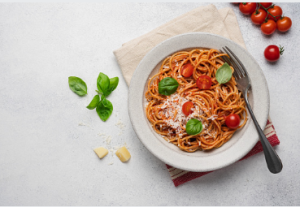It may seem strange initially, but pasta can be great for lunch or dinner. Not only is it tasty, but it can also be healthy. Some types of pasta are rich in protein, and others have low GI (glycemic index) ratings. These will make them less likely to cause blood sugar spikes and give you a healthier glycemic load.
Wholegrain pasta has more fibre
Wholegrain pasta has more fibre, and therefore more nutrients, than white flour-based pasta. Choosing whole-grain pasta can help reduce the risk of chronic diseases. It also helps you feel full for longer.
 The fibre in whole-grain pasta helps your digestive system work more efficiently. It may lower your cholesterol and increase your chances of maintaining a healthy weight. A healthier gut can reduce your risk of diabetes and other digestive diseases.
The fibre in whole-grain pasta helps your digestive system work more efficiently. It may lower your cholesterol and increase your chances of maintaining a healthy weight. A healthier gut can reduce your risk of diabetes and other digestive diseases.
Whole-grain pasta is also higher in certain micronutrients, such as copper, manganese, and phosphorus. These micronutrients help your body fight off infections and boost your immune system.
There are many varieties of pasta, ranging from traditional white to gluten-free options. Some manufacturers even add extra fibre to their refined-grain pastas. However, these added benefits may not be as important as the health benefits of whole grains.
A study found that eating more fibre can help blunt blood sugar spikes and encourage regular bowel movements. Similarly, whole grains may reduce the risk of some cancers, such as colon cancer. They are also good sources of B vitamins, which are essential for a healthy nervous system.
Whole grains are also low in calories, which makes them a great choice if you’re trying to stay on a diet. While refined pasta has fewer calories, it’s not necessarily an alternative for losing weight.
Many manufacturers combine whole wheat with refined flour to create a more nutritious and less-calories version of their usual pasta. Those new to whole grains might find it helpful to mix a little of both into their meals.
For those interested in the health benefits of whole grains, 100 percent whole-grain pasta is a good choice. It contains all three layers of a wheat kernel, including the bran and germ.
High-protein pastas are cheaper
High protein Adelaide pasta is an inexpensive and tasty way to pack your diet with the requisite protein without the excess calories or saturated fat. These noodles are made with high-quality protein-rich ingredients and can be used in many of the same dishes as regular pasta. They are especially useful for those on a restricted diet or training for a big race.
The best way to tell if a protein-rich noodle is right is to read the ingredient list carefully. While most pastas contain water and wheat flour, some are made from legumes like chickpeas and red lentils. As such, they are much lower in carbs and higher in fibre.
In addition to pasta, protein-rich soups and sauces are a great way to sock your waistline. Lean meats, poultry and fish are also healthy alternatives to the fatty kind. However, it’s still a good idea to watch the fat content. You’ll want to avoid products that contain trans fats or saturated fats.
Some of the better protein-rich pasta are a cinch to prepare, so you won’t have to sacrifice quality for convenience. For example, Cybele’s pasta oozes quality and is available in various interesting flavours. Another option is Good & Gather’s red lentil spaghetti.
Choosing the best crop involves knowing which brands are worth your hard-earned money. A quick perusal of your local grocery store will reveal the names of a few worthy contenders. If you’re unsure where to start, check out the ingredient list on the box. Most of the best noodle options are made with enriched flours, but you’ll find some that aren’t.
Low-GI pasta helps reduce your glycemic load
If you’re looking for ways to control your glycemic load, pasta is one food to consider. Whole-wheat pasta is a good choice. It’s low in carbohydrates and high in fibre. Combined with other healthy dietary patterns, it can help you lose weight.
The GI (glycemic index) rating is a relative measure of how quickly carbohydrates raise blood sugar levels. Usually, foods with a high GI raise blood glucose more rapidly than those with a low GI. High GI food also increases insulin and may contribute to cardiovascular disease. However, the GI is only one factor to consider. Other factors include how you eat, your medical history, and your lifestyle.
Many studies have shown that low-GI foods are beneficial for managing diabetes. In particular, they reduce glycated hemoglobin, fructosamine, and HbA1c. They also help control appetite, resulting in a sustained energy level.
Researchers have also investigated the effects of low-GI pasta on adiposity. These studies looked at the impact of pasta on waist circumference and sagittal abdominal diameter.
These studies found that pasta in low-GI dietary patterns reduced BMI by 0.16 kg/m2. However, these results are insufficient to rule out the possibility of substantial heterogeneity.
A primary pooled data analysis indicated that low-GI dietary patterns did not contribute to adiposity. Adiposity was estimated using generic inverse-variance random-effects models.
High-protein pastas provide up to 11-12 grams of protein per cup
Choosing high-protein pasta can be a great way to add more protein to your diet. Most high-protein pastas contain more than double the protein of regular pasta. These noodles are also low in gluten.
Comments are closed, but trackbacks and pingbacks are open.